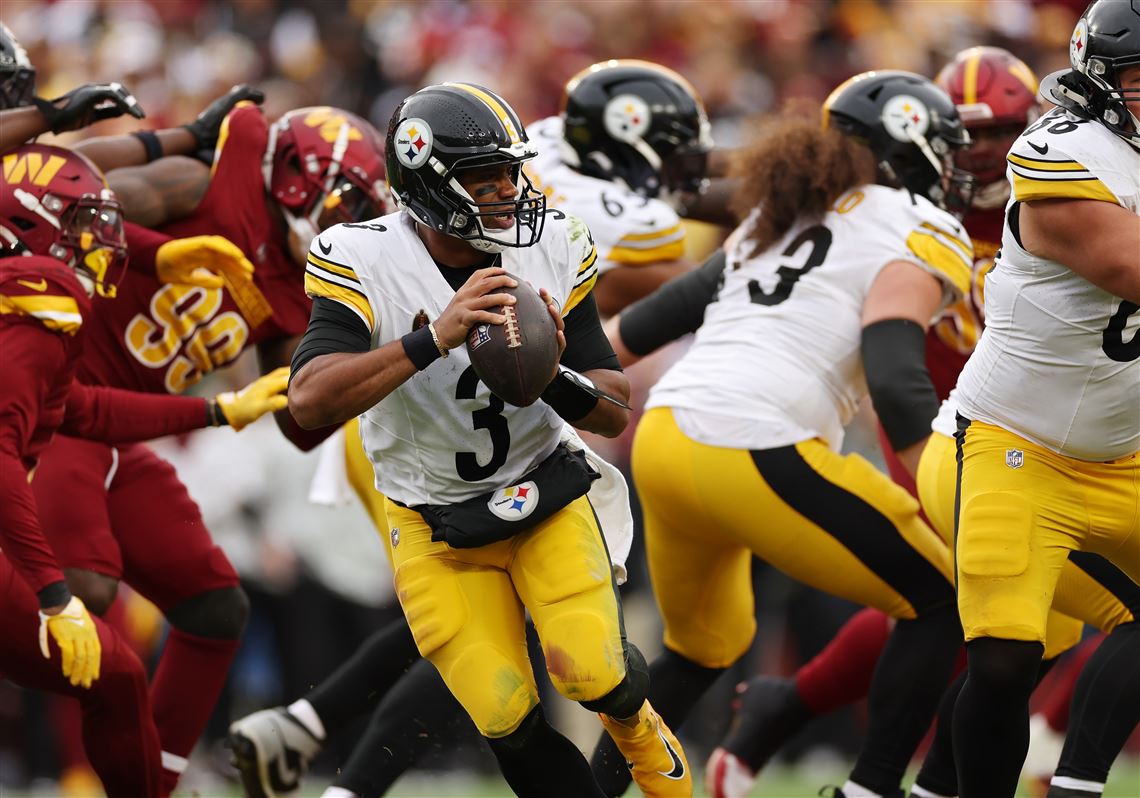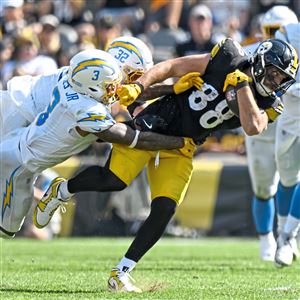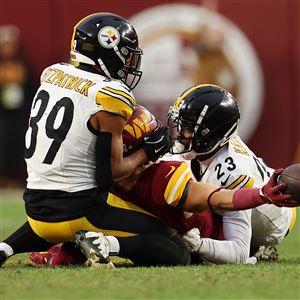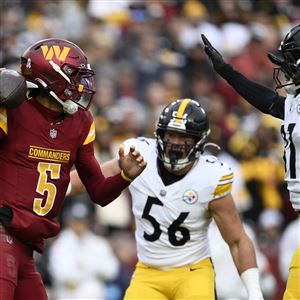Russell Wilson’s pre-snap recognition of opposing defenses has been a key factor in the offense averaging 30.3 points across his first three starts for the Steelers.
While Justin Fields’ athleticism was an asset that helped the Steelers’ offense, study of his film across six games showed opportunities in Arthur Smith’s offense for more downfield passing that weren’t regularly taken. But three weeks into the Wilson experience, downfield passing has been a major boost to the Steelers’ offense.
On passes that have targeted a receiver 20 or more yards downfield, Pro Football Focus (PFF) charts Wilson with completing 8 of 15 passes for 261 yards, three touchdowns and one interception. His 17.4 yards per attempt average is the highest among all NFL quarterbacks who’ve thrown at least 15 such passes.
Three of those completions came for 72 yards and two touchdowns Sunday against the Commanders. Despite these being deeper throws, many of them have come from quick decisions on short drop-backs in the pocket. That indicates Wilson is calculating those shot plays based off pre-snap reads and quick decisions based off what opposing defenses show at the start of plays.
One such play came on a 24-yard completion where Commanders defensive end Clelin Ferrell lined up in the neutral zone to give the Steelers a free play. Wilson quickly recognized he had single coverage against George Pickens. The throw comes out within three seconds of the snap, and the ball is well placed for Pickens to make a solid sideline reception.
Defenses know the threat Pickens is in the Steelers’ offense, as he’s accounted for 639 of the Steelers’ 1,862 receiving yards through 10 games — the next closest player being tight end Pat Freiermuth with 281. Because of that, defenses will often roll an extra safety overtop of Pickens and/or concentrate its coverage to take away Pickens for most of the game.
But a good quarterback recognizes the rare instances when a defense lightens its effort to limit your top receiver. Wilson has shown the ability to not only recognize those opportunities for Pickens, but also identify when the coverages are being disguised.
“I thought his experience could be an asset to our unit and our team, and that has played out,” Mike Tomlin said during his Tuesday press conference at UPMC Rooney Sports Complex. “His talents, his appetite for big moments, and I think that's played out some. But, you know, there's a myriad of reasons, and I just think it'll be continually revealed because of the circumstances that he and we will be in.”
One of those moments came on a 2nd-and-20 situation during the third quarter, when the Commanders showed a Cover 2 shell with two high safeties but rotated to Cover 3. When that happened, the cornerback overtop of Pickens dropped back into a deep-thirds coverage, which precluded him from being able to jump over Pickens’ in-breaking route without giving up the chance of a deep ball.
Because the middle safety rotated to the opposite side of the field, Wilson just had to look off the coverage for a moment to allow Pickens to have a clean run on his slant. The ball arrived on time, and Pickens turned an 18-yard throw into a 34-yard gain.
Wilson has also proven to be efficient against the blitz, where teams had tried to throw Fields off his rhythm at times. Out of quarterbacks who’ve faced the blitz more than once this season, Wilson’s 11.0 yards per attempt against is the best rate.
Much of that comes from Wilson’s ability to identify the blitz and adjust his post-snap reactions to counter where the defense doesn’t have an extra defender. On the Steelers’ first-quarter 16-yard touchdown pass to Pickens, Wilson used a hard count to get the Commanders to tip their hand on a blitz, which allowed him to call a check at the line in the protection.
Usually with a blitz, a defense is more likely to not have two deep safeties, as it would expose many holes underneath. That meant Pickens’ alignment as the outside receiver could isolate him in single coverage, unless the deep middle safety came to help.
As the Commanders’ blitz attacked Wilson, he held the safety in the middle of the field with his eyes, then quickly launched a jump ball for Pickens in the end zone.
But Wilson has to be able to find players not named Pickens out of the blitz, as well. That’s where he also hurt the Commanders for multiple big plays, and he shows on tape that he can compound off his success in reading defenses that try to take away specific throws from him.
“We’ve got guys that can make plays,” Wilson said in a CBS interview. “I like to facilitate the ball to different guys in different moments.”
That’s where Wilson’s ability as a facilitator of the offense comes to be the most useful; as opponents try to take away one or two factors in the Steelers’ offense, he can find another playmaker on his team who can bring success.
During the third quarter, Wilson faced another blitz from the Commanders on a 3rd-and-8. Running back Jaylen Warren ran a delayed release out of the backfield.
Once Wilson saw Warren slip past the blitzing linebacker, the check-down pass turned into a 26-yard completion, as the Commanders’ lone safety in zone coverage backed far off Warren and gave him space to make the play.
That play would later set up Wilson’s game-winning touchdown pass to receiver Mike Williams. On 3rd-and-9, the Commanders threw another blitz that got pressure into Wilson’s pocket in quick order. But a pre-snap read could identify that only two members of the secondary were to the side of Williams and Warren.
That allowed for Wilson to make a quick post-snap decision based off seeing the pre-snap alignment; if the deep safety stayed back to help guard against the deep ball to Williams, Wilson could target Warren for another check-down pass like he did in the third quarter for a big gain.
But instead, that safety came up to guard against Warren, which opened up the space for Wilson to quickly throw the deep ball to a spot for Williams to attack in the end zone, leading to the touchdown.
Wilson isn’t up for any MVP conversation, but he’s working his way to potentially be the NFL’s Comeback Player of the Year if he keeps up this pace of play.
What’s made Wilson’s strong start even more impressive is how quickly he’s found these opportunities in a new system in just three games. Wilson had just come from playing two seasons with the Broncos and missed the majority of training camp and six weeks of the regular season with an injury.
Tomlin sees part of the reason for Wilson’s success is his willingness to be malleable for the Steelers’ coaches to get him to fit with their style of play.
“Sometimes, you see guys that's been around as long as he [Russell Wilson] has ... they're somewhat resistant to new things or critiques and things of that nature, avenues in which men get better,” Tomlin said. “He's not resistant to any of those things, and that makes it fun, as well.”
First Published: November 13, 2024, 10:30 a.m.
Updated: November 14, 2024, 3:36 a.m.































